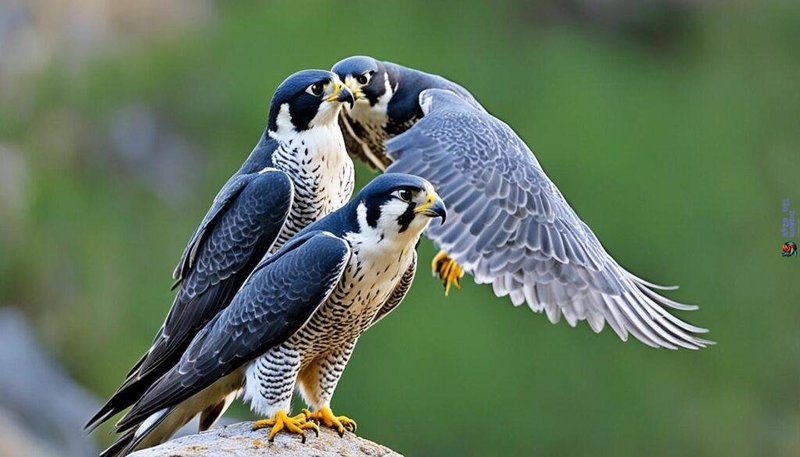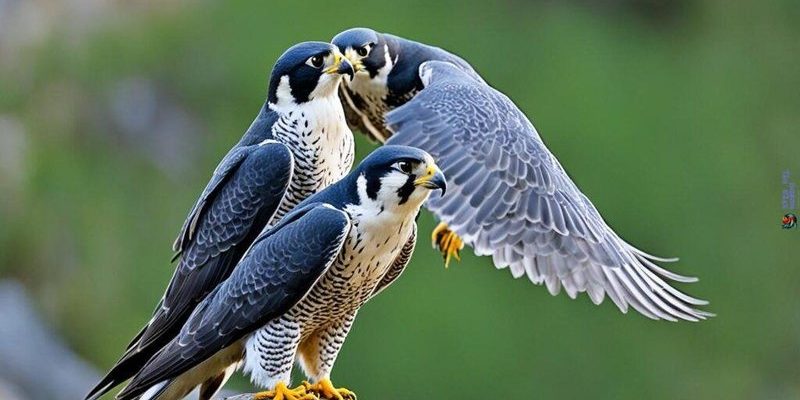
Falcons engage in elaborate courtship displays that are both breathtaking and crucial for their reproduction. Understanding these rituals not only offers insight into falcon behavior but also shines a light on the importance of their habitats and conservation. So, grab a cup of coffee, sit back, and let’s dive into the captivating courtship and mating rituals of these incredible birds!
The Dance of Courtship: Aerial Displays
When it comes to falcon courtship, nothing captures attention quite like their aerial displays. During mating season, male falcons often put on a spectacular show. Picture this: the male falcon takes to the sky, performing sharp dives, swoops, and impressive loops. It’s like watching a high-flying ballet, and it serves a crucial purpose. These aerial displays signal to females that the male is fit and ready to mate.
One of the most common courtship behaviors is called “looping.” The male will climb high into the sky and then spiral down, sometimes even issuing a series of calls to showcase his presence. Why do they do this? Honestly, it’s all about attracting the attention of a female. The more impressive the flight, the better the chance of catching her eye. If she’s impressed, she might even respond with her own forms of display. It’s like a conversation where both parties are showcasing their best moves!
Another delightful aspect of falcon courtship is the exchange of food. Males often bring prey to females as a way to demonstrate their hunting skills and ability to provide. This behavior not only strengthens the bond between partners but also plays a role in their eventual nesting success. After all, a well-fed female is more likely to choose a mate who can help ensure their offspring thrive.
Nesting: The Next Step in Love
Once the courtship rituals lead to a solid pairing, it’s time for nesting. Falcons are typically site-faithful, meaning they return to the same nesting site year after year. This could be a cliff ledge, a tall tree, or even a man-made structure. Nesting sites are crucial because they not only provide safety from predators but also a perfect vantage point for hunting.
Here’s the thing: building a nest isn’t just a simple task. The female falcon plays a significant role in selecting the perfect location. She considers various factors, including the availability of food and safety from threats. Once a suitable site is chosen, both partners work together to prepare it. This can involve scrapping together sticks, grass, and other materials to create a cozy home for their future chicks.
If you think about it, this part of the falcon’s life cycle is a team effort. The couple’s cooperation in nesting reflects the strength of their bond and their commitment to raising young together. It’s pretty heartwarming when you think about how these birds rely on each other for success.
Egg Laying: The Culmination of Courtship
After all the beautiful courtship and nest preparation, it’s finally time for the female falcon to lay eggs. Generally, she will lay between 2 to 6 eggs, depending on the species and environmental conditions. The timing of egg-laying is crucial; it usually aligns with the peak abundance of food sources to ensure the chicks have enough to eat.
The female will incubate the eggs, while the male takes on the task of hunting and bringing food to her. This division of labor is essential because it maximizes the chances of survival for their future chicks. You might be wondering how long the incubation lasts. Typically, falcon eggs take about 30 days to hatch. During this time, the male continues to impress by showcasing his hunting skills, ensuring both his mate and future offspring are well-fed.
Once the eggs hatch, the couple’s hard work doesn’t stop. They transition from laid-back romance to dedicated parenting, teaching their chicks the skills they need to thrive in the wild.
Parental Care: Nurturing the Next Generation
After the eggs hatch, falcon parenting becomes a full-time job. The parents work tirelessly to feed and care for their chicks, which are born helpless and covered in downy feathers. The mother continues to brood the chicks to keep them warm during the early days while the male hunts for food.
As the chicks grow, both parents take on a role in teaching them essential skills. Here’s a fun fact: young falcons learn how to hunt by observing their parents and practicing their aerial maneuvers. You can almost picture a young falcon awkwardly flapping its wings, trying to mimic its parents’ prowess! This learning process is critical for their survival. Eventually, the young falcons will practice flying and hunting on their own, preparing them for an independent life in the wild.
Once the chicks are ready to fledge, they leave the nest but continue to rely on their parents for food and guidance. The bond between the falcon family is strong during this period, as both parents support their young until they can fly solo.
The Significance of Courtship Rituals
You might be wondering why understanding falcon courtship and mating rituals is important beyond sheer curiosity. For starters, these rituals are indicators of overall bird health and environmental conditions. When falcons are thriving, it often means that their habitat is healthy and that they have plenty of food sources. Conversely, declines in falcon populations can signal issues in the ecosystem that may affect other species, including humans.
Additionally, awareness of falcon behaviors promotes conservation efforts. By understanding their needs during courtship and nesting, we can better protect their habitats and ensure their survival. Simple actions, like supporting local conservation initiatives and preserving natural spaces, can make a big difference.
Furthermore, falconry enthusiasts and bird watchers often find joy in observing these rituals. It fosters a deeper appreciation for these majestic birds and the intricate patterns of life they embody.
In wrapping up our journey through the courtship and mating rituals of the falcon, it’s clear that these birds are not just skilled hunters—they are also masterful partners and devoted parents. From the stunning aerial displays that capture a mate’s eye to the nurturing care of their young, falcons embody a fascinating blend of beauty and instinct.
Understanding their rituals helps us appreciate the intricate web of life and the importance of preserving these magnificent birds and their habitats. So, the next time you spot a falcon soaring overhead, take a moment to marvel at all the hard work that goes into forming a family in the skies. Let’s celebrate these incredible creatures and the natural world around us.

